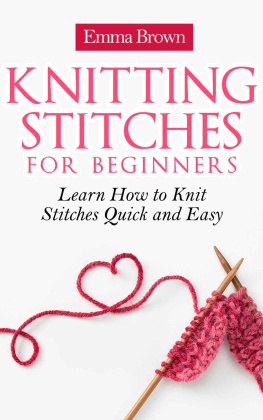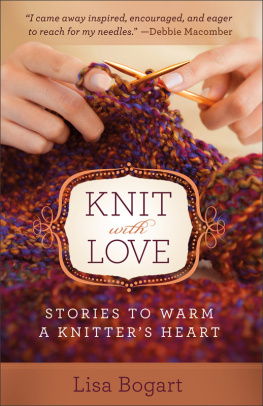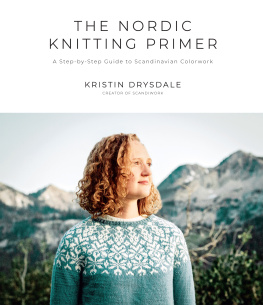


Knitting Art
150 Innovative Works from
18 Contemporary Artists
Karen Searle

Frontis:
Doppo Italia | Carolyn Halliday | 2002 | hand-knit copper and aluminum wires, brass wire filling | 14" tall
Carolyns double-layer wire torso celebrates the beauty of imperfect female bodies. Photograph by Petronella Ytsma
Title, main:
Living Cave | Debbie New | 1995 | handknit in mixed fibers | 3' 4'
Debbies visit to slot canyons in Arizona inspired this interpretation in stitches.
Title, inset:
No Strings Attached | Adrienne Sloane | 2006 | machine-knit linen rug warp | 37" h 47"
Adrienne created this knitted installation as an ironic feminist statement.
Contents:
Sense Spin | Janet Morton | 2000 | hand-knit audio cassette tape
Janet created this piece for Persistent Melody, a gallery installation on the theme of music and memory. The cassette-tape tornado, embellished with feather monarchs, is suspended over a record turntable.
Acknowledgments
A great many thanks go to the seventeen artists included in this book who graciously allowed me to spend time with them. I am grateful to Kari Cornell and Michael Dregni of Voyageur Press, who bravely and enthusiastically took on this topic and have made the entire authoring process a delight. Thanks also to Melanie Falick for having the insight to requisition an article on this subject back in 2001. I greatly appreciate the help and encouragement I have received for this project from Doroth Mayer, Lindsay Obermeyer, Suzanne Baizerman, Sarah Quinton, Ruth Scheuing, Carrie Lederer, Liz Collins, Arline Fisch, Janet Lipkin, Rob Hillestad, W. David Phillips, and Patricia Abrahamian. I am also grateful to my students and to the many artist-knitters who have been keeping me informed about their work over the years.

Homage to the Goddess, Creation | Karen Searle | tablet-woven silk, metallic threads, and beads knitted and crocheted around a chair frame
One of a series of goddess thrones, this chair honors creation myths and legends from many cultures in a folk-art style. Photograph by Karen Searle

Contents
Introduction
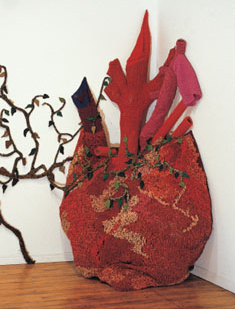
Tending | Janet Morton | 2003 | hand-knit heart, vines, and leaves, 2500 recycled soda bottles | 12' tall
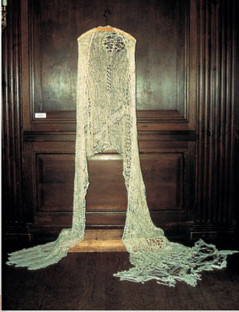
Portrait of Alzheimers | Katharine Cobey | 1992 | knit of handspun silk and wool, stabile, wood base, hanger | 69" h 77" w 28" d
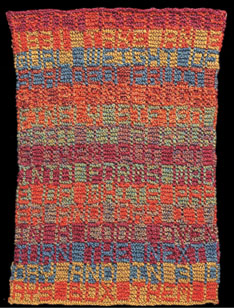
Fruit from the handknitted letters series | John Krynick | knitted thread | 6" 8"
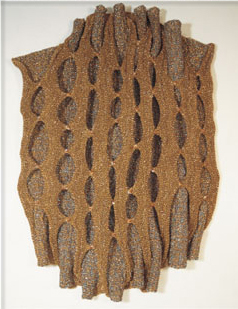
Channels from the Channels and Openings series | Donna Lish | 2005 | two machine-knitted layers stitched together | 23" h 16" w 1.5" d
Symbolism can be read into each stitchit is a loop without beginning or end. Interconnected loops can be a metaphor for life and human connectedness.
Karen Searle
Although the technique of knitting with knitting needles has existed for about 900 years as a practical means of making clothing and household textiles, only rarely was it used conceptually before the 1960s, when a small number of artists began to explore knitting for its artistic potential. That number grew slowly during the 1970s and 1980s in the United States; somewhat more rapidly in Europe and the UK. Now, with a resurgence of interest in knitting during the past decade, new and longtime knitters have been revitalizing the craft and expanding its creative possibilities. As an artist who has created knitted art objects for some thirty years, I have been fascinated by how conceptual fiber artists have approached knitting and especially how some artists have used knitting techniques to explore the meaning of womens work or domestic textile practices.
What is sparking the renewed interest in knitting, and why are more and more knitters venturing into utilizing knitting as a conceptual art form? There are multiple reasons. New publications, an abundance of yarn shops, and the rise of knitting circles and community knitting projects all have supported the renaissance. The evolution of technology, including Internet sites and weblogs, has connected knitters in new ways and stimulated a flow of ideas. Renewed interest in the domestic arts and in the handmade among artists and art students has widened the parameters of what is possible, as they adapt and reinvent knitting to suit their expressive purposes. And performance-based artists place knitting in the public arena with projects that involve audience interaction.
With the increasing popularity of knitting as a medium for artistic expression also comes a welcomed increase in the number of art galleries willing to exhibit knitting, crochet, and embroidery as art. The most significant validation for art knitting so far in the United States resulted from an international exhibition, Radical Lace and Subversive Knitting, held at the Museum of American Design in New York in 2007. Carrie Lederer, curator of the Bedford Gallery in Walnut Creek, California, who organized the 2006 exhibition Embroidered Stories, Knitted Tales, says of this trend:
The craft and art of knitting dates back to the twelfth century and employs forms, tools and techniques that have been handed down through countless generations. Artists today who use knitting to create contemporary art offer us a bridge from what we thought we knew about needle artsas womens work or craftto a new appreciation of a medium with endless artistic potential. Using historic media embedded with modern issues, artists have fully embraced yarn art to create works that collapse the presumption that these traditional practices are for conventional use only.
Fiber Arts Beginnings
Art knitters are part of a broader field of artists who use fiber and fabric as an artistic medium. During the Middle Ages in Europe, knitting was largely under the domain of the craft guilds, and master knitters were honored for their technical virtuosity. In the mid-eighteenth century, the mechanization of textile production and the increasing use of knitting machines gave birth to a rapidly growing home handcrafts industry directed toward women, which included published patterns for a wide range of needle arts. Although the Arts and Crafts Movement fostered a renewed appreciation of the handmade in the late nineteenth and early twentieth centuries, the attitude that craft was practical and functional and not considered fine art prevailed. This attitude was reinforced by art critics who touted painting and sculpture as the only true art forms.
Next page

